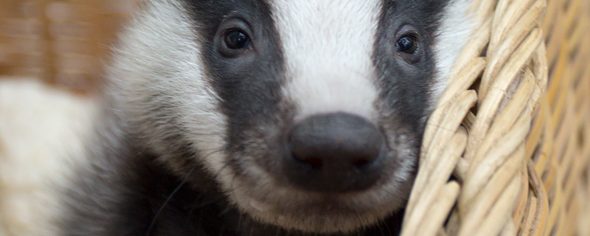
A recent scientific paper in Veterinary Record (1) by independent researchers Tom Langton, Mark Jones and Iain McGill, showing the effects of badger culls on bovine TB herd breakdowns over the last decade, has been met by criticism from officials at the top of Defra. There are accusations that it is ‘flawed’, and in the Daily Telegraph, even of data ‘rigging’ . You can view a 3 minute video of the main findings here.
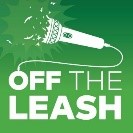 Further details on the origin and contents of the paper are discussed in a 40-minute Off the Leash interview by Charlie Moores with two of the authors Tom Langton and Mark Jones, here.
Further details on the origin and contents of the paper are discussed in a 40-minute Off the Leash interview by Charlie Moores with two of the authors Tom Langton and Mark Jones, here.
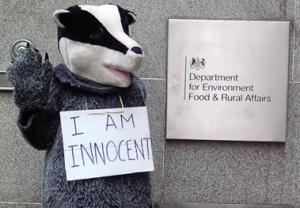
Many badger campaigners will know Mary Barton, aka Betty Badger, who stands up for badgers outside Defra offices each Thursday, and has done for many years. On Thursday 17th March, she was granted a meeting in person with Environment Secretary George Eustice. He told Mary that he thought the study was ‘flawed’. Then on 18th March, Defra put out a dramatic press statement, criticizing the content & motivation of those involved in writing, reviewing, and publishing the paper (2) :
“This paper has been produced to fit a clear campaign agenda and manipulates data in a way that makes it impossible to see the actual effects of badger culling on reducing TB rates. It is disappointing to see it published in a scientific journal.”
and
“Experienced scientists from the Government’s Animal and Plant Health Agency have reviewed the report and found its analysis is scientifically flawed. It has manipulated the data in a way that makes it hard to understand the actual effects of badger culling and therefore its conclusions are wrong. Today, the Chief Veterinary Officer, Christine Middlemiss, and Chief Scientific Adviser, Gideon Henderson, have also published a letter in Vet Record, which rebuts the report’s claims. The CVO has also written a blog about this.”
Which stated (3):
“We do not believe the scientific methodology used is credible as the analysis has been carried out in an unusual manner ”
These are confident words from the chief vet, informed no doubt by James McCormack (Head of Science Advice to Defra TB policy) and Eleanor Brown (Defra’s Veterinary Head for TB Policy Advice) to try to prevent acceptance of what are the plain and simple findings from Defra’s own data. The new analysis has been extensively checked using appropriate models, peer-reviewed by 4 reviewers, and accepted as a solid piece of research. In truth the 2021 badger culls should have been put on hold in June of that year because the basic findings were clear then and Defra knew about them.
However, the Defra Chief Scientific Advisor and CVO claimed in a letter to Vet Record on the day of publication (4) that “This analysis has been carried out in a manner that masks the effect of culling by incorrectly grouping data.”

Defra’s alternative analysis, shown above, has done something strange to diminish ‘unculled’ area data, that is not explained, yet which appears to undo their own argument. The letter states that the ‘impact of culling on cattle outbreaks takes some time to appear’ while showing steep decline in bTB in the first two years of culling. Oops!
All scientific studies have limitations and none are 100% correct. What Defra are doing in their letter is adopting a pro-cull narrative to promote their policy publicly, with an un-peer reviewed analysis. They are avoiding the sharp reality of what their data is really telling them, and George Eustice and the government should be very concerned about this.
Defra have defended their pro-cull policy in Parliament and in the High Court using a government study from 2019 that uses very small amounts of data (Downs et al. 2019 (5)), wrongly, as ‘proof’ that badger culling ‘works’. That paper in fact admits that there are enormous limitations to its conclusions. The position that ‘culling works’, however, has been widely adopted by the Minister, MPs, the NFU and farming stakeholders.
It’s in the herd: cattle measures are the answer
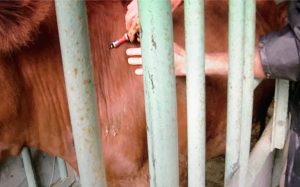
Defra have dismissed in a short soundbite, one of the most interesting findings of the published paper: the disease slowing, peaking and declining between 2011 and 2016 across the HRA counties, and before badger culling began in all but one area. Defra want to adjust the data for confounding variables. Such adjustment is something that only Defra can do, as they alone have access to this ‘secret’ data. But adjustments are hardly likely to substantially change the conclusions, when such a huge dataset has been used in the analysis (over 20,000 herd a year). Mention has been made of changes in badger cull buffer areas and badger population numbers, but the strength and validity of that data is questionable and presently obscure.
The Defra letter is particularly disappointing, given that Defra/APHA should have been using data to closely monitor and inform the public on the effects of bTB interventions and to ‘adapt and learn’ from their analysis. As they intimated would be the case in a Judicial Review of culling in the High Court in 2018, and as the judgement anticipated. And to encourage and inform those involved in the grueling cattle testing effort. Shouldn’t the public, who are after all paying for all of this, demand that too? Ask a simple question: why didn’t Defra do an analysis with the large data set they had available in 2019 and show the results? Was it because it showed that bTB was peaking and falling in both culled and unculled areas, well before badger culling was rolled out?
But that would mean admitting that cattle measures are the key ‘tool in the box’ to bTB control and need to be extended. BTB decline since 2015 has averaged around 5% per year in the HRA, very similar to the picture in Wales where badgers are not culled and also in Republic of Ireland (RoI). Badger culling is now being phased out in RoI, with long term use of annual SICCT and gamma testing, and with bTB OTFW incidence no lower than around 4%, due to the limitations of the SICCT test. International evidence points to cattle measures alone being the solution, as predicted by experts for over 20 years.
The answers are all here. BTB should keep coming down in the English HRA if it follows the RoI trend over the next 3-5 years. If modern PCR testing is applied, it could be dealt with well before 2030. If the will is there. The Edge area crisis is another matter, but could be turned around too with correct thinking and the right interventions.
Other specialist comment:
Prof Paul Torgerson from the Section of Veterinary Epidemiology at the Vetsuisse Faculty of the University of Zurich wrote an opinion editorial for Vet Record on 19th March (6) offering insights on why badger culling doesn’t work, as predicted by the government researchers conducting the Randomised Badger Culling Trial back in 2007.
The Defra and the Middlemiss/Henderson arguments have been more than dented.The authors of the new analysis have responded in the Veterinary Record (2nd April) letters pages (7), saying that Defra’s criticism of the paper is baseless, and their attempt to show alternative science lacks explanation in the way they have handled the data. Defra have discounted around half of the data and the figures they use do not match figures from the reference material. There is also a dead end Link. This could be interpreted as ‘data manipulation’ to try to defend existing policy-based science. Defra’s refusal to accept the Langton et al. analysis using all of the cull data over the whole period of culling, is effectively limiting consideration of one of the most important debates of farming and veterinary concern of the last 50 years.
Over £100 million of public money per year is paid to farmers each year to support bovine TB control, and over £90 Million has been spent killing around 180,000 badgers since 2013; £500 per badger.
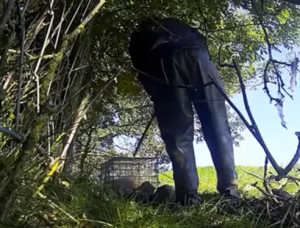
Defra’s position is that it wants yet more ‘thinking time’ to privately consider data and internal reports. Meanwhile, concerned observers can only watch while the decision on the course of the badger cull, where Defra aim to kill a further c.110,000 badgers from this June through to January 2026, hangs in the balance. The matter of efficacy needs settling. But Defra want to begin culling again this June and September with the issue of further licences.
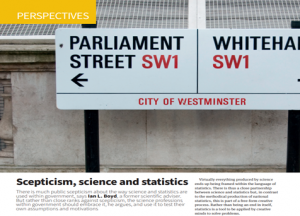
There is an irony here in as much as the attitude of Defra employees towards the new study appears to have formed a classic exemplar of what the retired Defra Chief scientific advisor (2012-2018) Prof. Iain Boyd has described recently as departmental ‘tribalism’ in his article in the Royal Society of Statistic journal Significance entitled ‘Scepticism, science and statistics’. Staff behaviour includes hostile over-reaction to anyone questioning government policy.
We can only hope that those involved will now resist that ‘unjustified tribal confidence’ and the ‘traditions embedded within their professional tribe’ and find the ‘social licence to break out’. For the sake of badgers, cows, farmers, the countryside and the public, they need to do it now.
Northern Ireland
DAERA (NI Department of Agriculture Environment and Rural Affairs) have been pressing for a badger cull in NI for some time and have rushed a consultation through recently to try to copy ‘English-style’ badger culling.
For many years Mike Rendle and the Northern Ireland Badger Group (NIBG) have been working with legal and scientific support from the Badger Trust and Eurobadger. Working and meeting with government at Stormont to discuss the issue.
Developments since 2020 have been very disappointing and many who have been watching closely feel the DAERA process of considering interventions has been bungled and that it should have followed the Welsh model. For example, on the government’s own data there is a distinct lack of association (see below) between high badger density areas and high bovine TB incidence areas. The matter of DAERA’s concealed ‘business case’ for badger culling and why the badger intervention with highest environmental impact has been chosen remains unexplained. DAERA even dropped their ecological impact assessments (SEA/HRA) in favour of an earlier ‘dumbed down’ version. This followed an extensive critique, submitted by NIBG describing multiple failures in the proposals and with useful input from eco-regulations expert Dominic Woodfield.
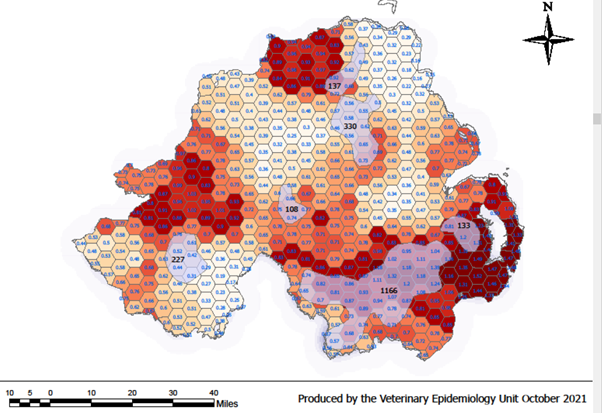
Now Wild Justice (8) (Chris Packham, Ruth Tingay and Mark Avery) have come to the fore and with NIBG are Judicially Reviewing the decision to shoot badgers on the basis of improper consultation regarding the business plan and cost-benefit analysis. This includes reference to the new paper on badger culling efficacy in Vet Record. Cattle movements in NI are less controlled than in England, and cattle measures alone should control bTB if a higher level of herd management discipline and more accurate testing could be introduced to cattle controls. But if Defra have been coaching DAERA, the road to ruin may have been laid.
References
(1) Langton TES, Jones MW, McGill I. Analysis of the impact of badger culling on bovine tuberculosis in cattle in the high-risk area of England, 2009–2020. Vet Rec. 2022;e1384.
(2) Defra media statement 18 March 2022.
(3) Christine Middlemiss blog 21 March 2022.
(4) Christine Middlemiss and Gideon Henderson letter to Vet record 19th March 2022.
(5) , , , , , , et al. Assessing effects from four years of industry-led badger culling in England on the incidence of bovine tuberculosis in cattle, 2013–2017.
(7) Badger culling to control bovine TB, letter to Vet record, Thomas ES Langton, Mark W Jones & Iain McGill. 2nd April 2022.
(8) Wild Justice Judicial Review
(9) Interview with Tom Langton & James Wood, Head of Department of Veterinary Medicine at the University of Cambridge, BBC Radio 4 Farming Today, 19th March 2022. Clickable button below.

Discover more from The Badger Crowd - standing up for badgers
Subscribe to get the latest posts sent to your email.

